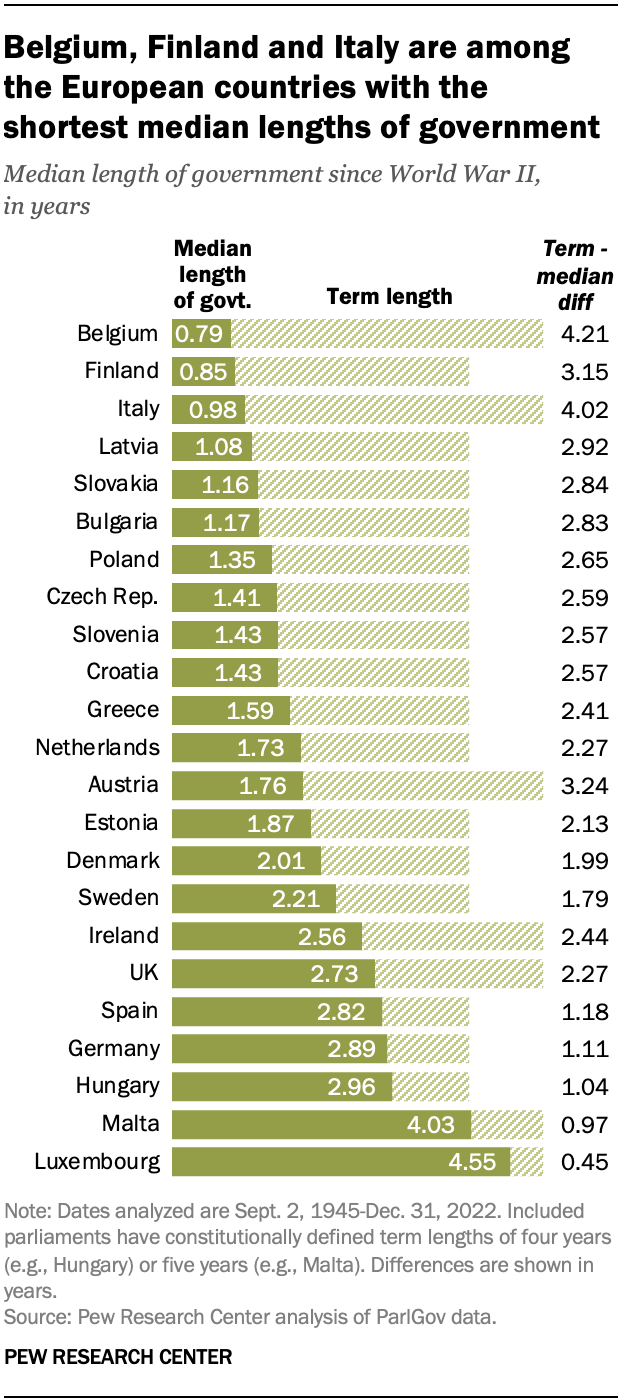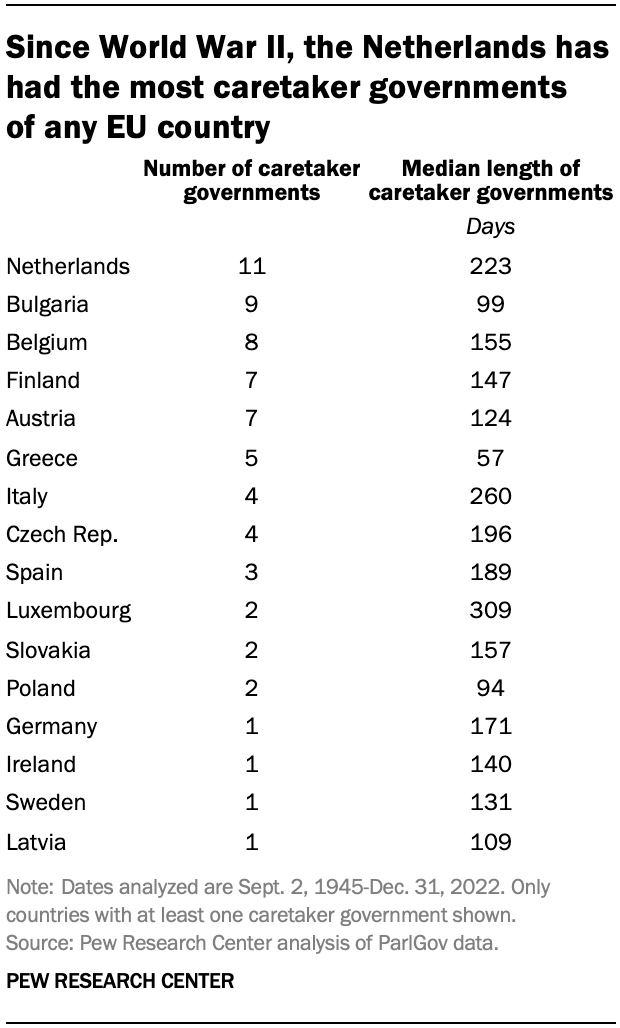
The United Kingdom had three different prime ministers in 2022, including Liz Truss, who served for only 49 days. Truss’ brief tenure raises the question: How long do governments in Europe tend to last?
To find out, Pew Research Center consulted ParlGov – a clearinghouse for cross-national political information – and calculated the median length of government in the 22 parliamentary member states of the European Union, as well as the UK, from the end of World War II through the end of 2022.

Overall, most of the European countries analyzed have seen changes in government at least once every two years. But governments in Belgium, Finland and Italy often haven’t lasted even a single year. In these countries, the median length of government since World War II has been less than 365 days – far less than the full constitutional terms afforded to a new government.
On the other end of the spectrum, Luxembourg has had the longest median length of government among the countries analyzed: more than four and a half years. Governments in Luxembourg have also come the closest to reaching their full constitutional terms (five years, in Luxembourg’s case).
Most EU countries are parliamentary democracies and, depending on the country, hold regular national elections every four or five years. In parliamentary democracies, the party (or parties) that wins the most seats in parliament forms the government (or cabinet) and selects the head of state. The length of government in this analysis is defined as the number of continuous days that the government remains in power before the next national election.
If a government has shifted into a “caretaker” role, meaning the administration operates with a limited legislative mandate, it is considered a new government in this analysis. For example, in Germany, former Chancellor Angela Merkel’s 16-year reign is broken down into five distinct governments: three governments consisting of traditional four-year terms; one caretaker government that lasted half a year as Merkel struggled to form a government; and a final three-and-a-half-year term once she eventually succeeded in building a coalition. (Read “How we did this” for more about the methodology of this analysis.)
This Pew Research Center analysis compares the median length of government across parliamentary systems in the European Union and the UK since the end of World War II. The data used to calculate the lengths and types of governments as well as each country’s election history is drawn from ParlGov (accessed November 2022), a clearinghouse for cross-national political information.
Our definition of “length of government” is based on ParlGov’s tracking of cabinets. In their data, a new cabinet is recorded following one or more of the following events: a change of party within the existing cabinet, any change of prime minister or head of government, or any general election. We include caretaker governments, defined as “cabinets with a limited legislative mandate.” (Read more country-specific information and examples of how ParlGov codes changes in government.)
ParlGov has a record of cabinets going back as far as the country is considered fully democratic, per Boix et al.’s dichotomous classification (2013). We begin our tracking with the first cabinet in office post-World War II (on or after Sept. 2, 1945), then use official government websites to assess the status of governments through Dec. 31, 2022. Any manual changes to the data are listed below:
- In the Czech Republic and Slovakia, we calculate the length of government based on cabinets since 1993 – when they became independent sovereign states – rather than 1990, when ParlGov’s data on these countries begins.
- In Malta, tracking begins with the government in power in 1964, when the island became a nation independent of British rule.
- In Italy, Sweden, Latvia, Denmark, the UK and Bulgaria, we updated the list of governments to reflect recent changes in government not yet added to the database, which was last updated on Sept. 9, 2022. Dates were verified using official government websites in each country.
How do governments transition?
Once a government fails – whether through a vote of no confidence, a resignation or the restructuring of a cabinet – a new one forms in one of two ways:
- Coalition building: In parliamentary democracies, it can be common to form or re-form governments between scheduled elections. For example, although the UK had three prime ministers in 2022, the transitions occurred without the general public going to the polls. This type of process has occurred in every country included in this study and has been particularly common in Belgium, Estonia, Finland, Italy, Latvia, Poland and Slovenia, where there have been at least two government transitions per election term (four or five years), on average.
- Snap elections: If a government collapses before an election is scheduled to occur, countries may call “snap elections” to form a new government. For example, in 2022, Slovenia had its first regularly scheduled election in over a decade after holding snap elections in 2011, 2014 and 2018. In 2022, two of the 23 countries included in this study – Bulgaria and Italy – held snap elections.
For comparison, while Bulgaria and Slovakia’s governments have tended to last roughly the same amount of time (1.17 and 1.16 years, respectively, on average), Slovakia has been able to form and re-form coalitions without elections much more frequently than Bulgaria. And some countries, like Italy, have frequently formed governments through coalition building and held snap elections.
Who leads as a government transitions?
Some transitions involve caretaker governments. For example, the current prime minister of Bulgaria, Galab Donev, and his government are serving in a caretaker capacity after a vote of no confidence in the previous administration.

The Netherlands has had more caretaker governments than any other country in this analysis, with 11 since World War II. Current Dutch Prime Minister Mark Rutte has been in office for nearly 12 years, but of the seven consecutive governments he has led, three have been in a caretaker capacity. Most recently, he headed a caretaker government for 360 days from January 2021 to January 2022 – setting a postwar Dutch record. Belgium and Bulgaria have the next-highest counts of caretaker governments, with nine and eight, respectively. Finland and Austria follow with seven each.
In Luxembourg, even caretaker governments have tended to last long. Although the country has had caretaker governments on only two occasions since World War II, the median length of a caretaker government in Luxembourg is just over 10 months (309 days). Other countries with median lengths greater than six months include Italy, the Netherlands, the Czech Republic and Spain.
Belgium stands out for having the longest-lasting caretaker government of any country studied. Yves Leterme’s third government acted in a caretaker capacity for nearly a year and a half (541 days) between 2010 and 2011. Italy’s longest caretaker government was the only other one to surpass 500 days, with the government of Mario Monti holding power for 528 days in the wake of the European debt crisis.


